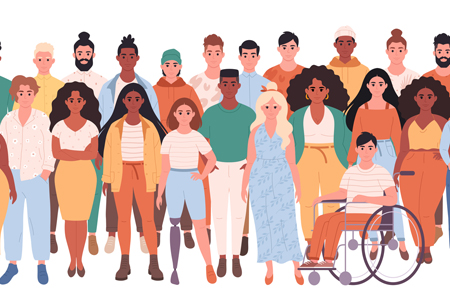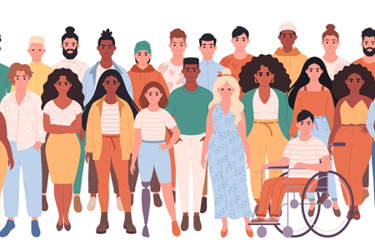Two Straightforward Ways To Improve DE&I In… Leave a comment

By Yashoda Sharma, program director, Digital Medicine Society (DiMe); Michelle Higginson, DiMe project partner, COO & cofounder of Inlightened; and Reginald Swift, DiMe project partner, CEO & founder of Rubix LS

Clinical trials are foundational to advancing healthcare through the discovery and application of new knowledge. However, opportunities to benefit from these advancements have been limited for many groups. Centuries-old systemic racist practices and policies have fueled health disparities and made diversity, equity, and inclusion (DE&I) challenges widespread and multifactorial.
There are over 434,000 clinical trials registered with Clinicaltrials.gov. However, data from the FDA indicate that 75% of trial participants in 2020 identified as white, while only 11% identified as Hispanic, 8% identified as Black or African American, and 6% identified as Asian. This issue of having little racial diversity in clinical trials is further compounded by the fact that 20% of all drugs have a variation in responses across ethnic groups. The most widely known example of this is the popular asthma drug albuterol, which does not work as well for children of African American and Puerto Rican ancestry. Despite the disproportionate prevalence of asthma in these populations, very few trials have been conducted with African American and Hispanic populations.
The pandemic hastened the involvement of digital health technologies (DHTs) and the adoption of decentralized clinical trials (DCTs), which are helping to meet participants “where they are” with tools like eConsent, virtual visits, online assessments, and remote patient monitoring. DHTs are becoming part of the entire clinical trial life cycle, from recruitment and retention to health data collection and data analytics. DHTs also present opportunities to impact the diversity, equity, and inclusion of clinical trials by increasing access, improving patient engagement and retention, and reducing logistical and operational burdens for patients and clinical teams. The prevailing thought is that such advancements will lead to better outcomes through the collection and analyses of more robust data sets.
While this progress is meaningful, a significant challenge still exists with securing patients’ trust of the clinical trial system. For DHTs to be most impactful, we need to build trust within underserved communities. One way to do this is by increasing the representation of these communities. Here, we share two digital solutions that can build trust by increasing representation.
Increasing Site Diversity
Minority patients tend to feel more trust toward minority healthcare providers — physicians, nurses, and allied healthcare professionals alike. More racially and ethnically diverse staff at investigator sites could lead to greater participation by more minority patients in clinical trials — a healthcare innovation that can help fix the broken process plagued by a lack of access, diversity, and transparency. Despite evidence that a physician’s race and ethnicity can influence the race and ethnicity of clinical trial volunteers and minority patients have better relationships with minority healthcare providers, the incidence of participation in clinical research among minority physicians is well below that observed among white physicians. Diversifying clinical trial personnel is a challenge, despite minority physicians’ interest in participating in clinical research being similar to that of white physicians. The primary reason for this is lack of access to the clinical trials industry or knowledge of how to participate.
Engaging and supporting healthcare professionals, including physicians and nurse practitioners, from all backgrounds to serve as principal investigators and sub-investigators will be critical to fulfilling the need for greater trial diversity. Creating digital networks for minority providers allows for a unique understanding and development of specialized expertise and for building a community and network of providers with a depth and breadth of clinical research that is relevant to more diverse populations. By providing opportunities and support for more diverse clinicians to participate, trust is established with providers so they feel comfortable sharing their expertise and knowledge with partners from across the clinical trials ecosystem and can better support and serve diverse patients through the clinical trials process.
Filling Real-World Data Gaps
We need to fill in data gaps for historically underrepresented populations by applying real-world data (RWD) from genomics and real-world evidence (RWE) from publicly available epidemiology and socioeconomic sources. A major challenge facing clinical trials is lack of data on diverse populations. Incomplete data is a consequence of historical discrimination and inadequate healthcare access, which continue today despite the volumes of data showing that minority populations suffer from greater incidence and mortality rates from numerous diseases. The consequences are not only limited information on biological processes or specific compounds to treat disease, but also missed opportunities to identify additional information that may serve to protect from disease incidences or severity or as novel compounds to explore.
The lack of data representative of diverse populations severely limits how new therapies will work in many populations that need treatment. Additional data from various populations, including African Americans, native tribes/First Nations, and LGBTQI — coupled with data science — can inform and enhance the patient journey and allow us to better understand diseases that truly impact all patients. From the severity of the disease to the histology and ethnographic patient experience, we would be able to seamlessly integrate the data sources to tell a data story of how to proactively design adaptable models for a more effective clinical trial design. Data intelligence conducted on data already captured can optimize engagement for clinical trials, for diverse patients and investigators. The patient journey for diverse patient populations is largely fractured due to insufficient access and care and a lack of knowledge by the patient or their community. The ability to “walk” with the patient during any phase of their journey provides asynchronous intelligence to help investigators, sponsors, and sites learn how to mobilize low-burden approaches to work with diverse populations.
Acting Now To Advance DE&I
We don’t have to wait for federal guidance, additional DHT, or new innovations. We have the tools to begin to address the lack of trust and limited data and incorporate them into diversity plans for clinical trials today. With more complete data on diverse populations, sponsors are better able to design clinical trials that are safer and more effective across races and ethnicities. With more diverse investigators, sponsors have greater support for ensuring more equitable and inclusive trials, which can lead to better retention and more complete data. Building trust through representation will be instrumental, with DHTs having a significant impact on improving clinical trials.
References:
Yearby R, Clark B, Figueroa JF. Structural Racism In Historical And Modern US Health Care Policy. Health Affairs 2022;41(2). https://doi.org/10.1377/hlthaff.2021.01466.
ClinicalTrials.gov. Trends, Charts, and Maps. Available from: https://www.clinicaltrials.gov/ct2/resources/trends#:~:text=ClinicalTrials.gov%20currently%20lists
%20423%2C814,about%204.5%20million%20visitors%20monthly. Last accessed Nov. 29, 2022.
Food and Drug Administration. 2020 Drug Trials Snapshot Summary Report. Available from: https://www.fda.gov/media/145718/download. Last accessed Nov. 29, 2022.
Higginson M. Equitable healthcare starts here: Industry takes aim at increasing diversity, equity, & inclusion in clinical trials. 2022. Available from: https://getinlightened.com/2022/06/28/dei-healthcare-clinical-trials/. Last accessed Nov. 29, 2022.
Israel E, Cardet JC, Carroll JK, et al. Reliever-Triggered Inhaled Glucocorticoid in Black and Latinx Adults with Asthma. N Engl J Med. 2022;386(16):1505-1518. doi:10.1056/NEJMoa2118813.
MD Group. Why Decentralisation Is The Future Of Clinical Trials. 2020. Available from: https://mdgroup.com/blog/why-decentralisation-is-the-future-of-clinical-trials/. Last accessed Nov. 29, 2022.
Inan, O.T., Tenaerts, P., Prindiville, S.A. et al. Digitizing clinical trials. npj Digit. Med. 3, 101 (2020). https://doi.org/10.1038/s41746-020-0302-y.
Tufts Center for the Study of Drug Development. Impact Report. New Study Finds Site Personnel Race and Ethnicity Highly Correlated with Diversity of Patients Enrolled. 2021. Available from: https://f.hubspotusercontent10.net/hubfs/9468915/Impact%20Report%20Preview.png. Last accessed Nov. 29, 2022.
Getz K, Faden L. Racial disparities among clinical research investigators. Am J Ther. 2008;15(1):3-11. doi:10.1097/MJT.0b013e31815fa75a.
Silverman E. Clinical trial sites face challenges in diversifying personnel and participants, study finds. 2021. Available from: https://www.statnews.com/pharmalot/2021/11/05/clinical-trials-diversity-inclusion/. Last accessed Nov. 29, 2022.
Welson-Rossman T. Healthcare Needs More Diverse Experts To Guide Innovation. 2021. Available from: https://www.forbes.com/sites/traceywelsonrossman/2021/02/09/healthcare-needs-more-diverse-experts-to-guide-innovation/?sh=350fb2f969e6. Last accessed Nov. 29, 2022.
Landry LG, Ali N, Williams DR, et al. Lack Of Diversity In Genomic Databases Is A Barrier To Translating Precision Medicine Research Into Practice. Health Affairs 2018:37(5). https://doi.org/10.1377/hlthaff.2017.1595.
Borrell LN, Elhawary JR, Fuentes-Afflick E, et al. Race and Genetic Ancestry in Medicine – A Time for Reckoning with Racism. N Engl J Med. 2021;384(5):474-480. doi:10.1056/NEJMms2029562.
Rubix Life Sciences. RUBIX Clinical Disparities in Disease Diagnosis and Patient Care. Available from: https://rubixls.com/wp-content/uploads/2021/05/RUBIX-Clinical-Disparities-in-Disease-Diagnosis-and-Patient-Care.pdf. Last accessed Nov. 29, 2022.
Sirugo G, Williams SM, Tishkoff SA. The Missing Diversity in Human Genetic Studies. Cell. 2019;177(4):1080. doi:10.1016/j.cell.2019.04.032.
Food and Drug Administration. Diversity Plans to Improve Enrollment of Participants From Underrepresented Racial and Ethnic Populations in Clinical Trials; Draft Guidance for Industry; Availability. 2022. Available from https://www.fda.gov/regulatory-information/search-fda-guidance-documents/diversity-plans-improve-enrollment-participants-underrepresented-racial-and-ethnic-populations. Last accessed Nov. 29, 2022.
About The Authors:
 Yashoda Sharma, Ph.D., is a program director at the Digital Medicine Society (DiMe), a 501(c)(3) nonprofit organization dedicated to advancing digital medicine to optimize human health. Her work has focused on patient engagement, recruitment, and retention for large, interdisciplinary academic research programs with a focus on advancing health equity. She is leading two DiMe initiatives: the Digital Health Measurement Collaborative Community and Diversity, Equity and Inclusion in Digitized Clinical Trials.
Yashoda Sharma, Ph.D., is a program director at the Digital Medicine Society (DiMe), a 501(c)(3) nonprofit organization dedicated to advancing digital medicine to optimize human health. Her work has focused on patient engagement, recruitment, and retention for large, interdisciplinary academic research programs with a focus on advancing health equity. She is leading two DiMe initiatives: the Digital Health Measurement Collaborative Community and Diversity, Equity and Inclusion in Digitized Clinical Trials.
 Michelle Higginson, MBA, is a long-time commercial operator in the healthcare space. She cofounded Inlightened in 2019 to connect client companies of all stages and sizes to a global vetted network of healthcare professionals. With an unprecedented focus on diversity, quality, and transparency, Inlightened is transforming the historically broken process of healthcare insight generation and clinical research and facilitating collaboration to advance innovations for all.
Michelle Higginson, MBA, is a long-time commercial operator in the healthcare space. She cofounded Inlightened in 2019 to connect client companies of all stages and sizes to a global vetted network of healthcare professionals. With an unprecedented focus on diversity, quality, and transparency, Inlightened is transforming the historically broken process of healthcare insight generation and clinical research and facilitating collaboration to advance innovations for all.
 Reginald Swift, founder and CEO of Rubix LS, uses innovation at a grander scale to change how health outcomes can be realized through patient product and service innovation. With a background in molecular mechanical engineering, many of his research pursuits also involve developing regenerative metals to target specific diseases such as multiple sclerosis for myelin regeneration, ALS, PLS, and PKAN. With a focus on observing the genetic variations within diverse patient communities, he’s using the power of design science to accelerate the next level of precision therapeutics that can be discovered through each person’s unique biological makeup.
Reginald Swift, founder and CEO of Rubix LS, uses innovation at a grander scale to change how health outcomes can be realized through patient product and service innovation. With a background in molecular mechanical engineering, many of his research pursuits also involve developing regenerative metals to target specific diseases such as multiple sclerosis for myelin regeneration, ALS, PLS, and PKAN. With a focus on observing the genetic variations within diverse patient communities, he’s using the power of design science to accelerate the next level of precision therapeutics that can be discovered through each person’s unique biological makeup.


